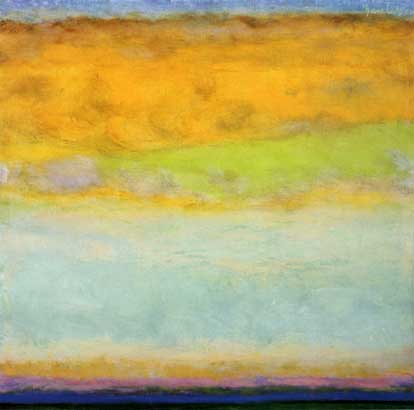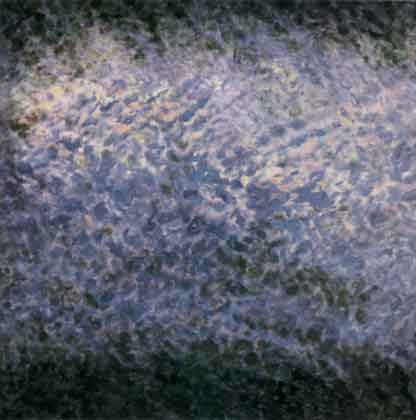
Eventide, 2002.
Oil on linen, 24" x 24".
| There are places
you can stand up or sit in the plains (where Jane Wilson grew up, in Iowa), or
along the shore (where she now has a house with her husband, in eastern Long
Island) and see a great deal of sky above and narrow strips of land and/or water
under that. Your eyes are the horizon, the dome of your brain a much smaller
version of the dome of the sky, even to the point of emulating, in reverse, its
dappled appearance and constant activity. Below the eyes, below the horizon,
is the rest of the body, the earth, undoubtedly though querulously connected
to the dome above. Lying on your back you only see the sky, horizontal now like
the horizon and far away, dreaming. The sky assumes the place of thought, of
making art. |
 Eventide, 2002. Oil on linen, 24" x 24". |
| Seeing, remembering, and imagining are combined. Wilson makes a few sketches and watercolors on site, presumably on or near the beach facing the Atlantic Ocean, or perhaps the bay side, but work on the paintings themselves is done in her New York City studio. Her head and eyes become the sky rising from sea and land. Weather becomes the equivalent of consciousness, which is always in the process of forming, changing, until immanence is reached, which is constant. The final painting is not the achievement of form or harmony but of a conditional immanent state, of which there have been several before in the process. In an interview with Justin Spring, Wilson quoted Joshua Reynolds saying about a portrait of his, "Underneath are many versions, some better, some worse." Wilson's paintings are compelling because we can see all those versions; they represent thought, and we automatically, instinctively, make the connection with our own sporadically attended thought processes. |
 Whirlwind, 2002. Oil on linen, 70" x 70". |
| When Jackson Pollock said, "I am nature," he seemed to be proclaiming himself, at least from the usual inflection it is given, an elemental force. It was, in a way, a declaration of independence from traditional ways of thinking about the subjects of art; about figures and still lifes and landscapes. In a sense, Wilson's paintings are curiously inverted expressions of that dictum, inverted because they both are nature and they are about nature. She knows that what is out there is infinitely changeable and that the painting process itself proves that there is a continuous connection, through her eyes and mind and what she has learned to do with her hand, between what is out there and what is in her. Every gesture of the brush is like a gust of wind, every infusion of color like an increase or decrease in moisture that affects the brightness and color of light. Except for the fact that you sense all the layers that have preceded the last one, you don't really know what is underneath. You do know from experience that what is there now evolved from something else, and that there are several patterns containing millions of possibilities: blues, yellows, reds, oranges, purples, grays, wispy shapes, turbulent, curvilinear shapes, mottled patterns, etc. The great yellow swath of Eventide spreads upward and outward in a way that balances the light blue sky and the dark blue horizon, but it also seems to obey its meteorological destiny. The quilted clouds of Whirlwind spiral toward the light in the upper half like a migrating flock of birds, paying attention to some secret geometry, just like the painter herself. Donald Goddard © 2003 |
| Except for the sun, there are no stars in Wilson's work, only a great cloud of knowing. |
Art Review - NYArtWorld.com - NYAW.com. All artwork is copyright of the respective owner or artist. All other material © Copyright 2015 New York Art World ®. All Rights Reserved.
New York Art World ® - Back to Top